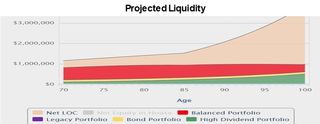How to Add Home Equity to Your Retirement Income Planning
Home equity is sometimes overlooked as a viable resource in retirement. You don’t have to sell your home to find income and liquidity.


With more retirees than ever choosing to age in place, the idea of selling your home to downsize may no longer be part of your plans.
That’s smart, because you don’t have to sell the homestead to produce retirement income and help cover the costs associated with a critical health crisis, or just the effects of aging that require outside care.
In the New York Times article The High-Class Problem That Comes With Home Equity, author Ron Lieber, the NYT’s Your Money columnist, suggests that reverse mortgages could be a good product for some retirees who want to tap the equity in their home without selling. We agree, and the Go2Income planning method can now incorporate a reverse mortgage.

Sign up for Kiplinger’s Free E-Newsletters
Profit and prosper with the best of expert advice on investing, taxes, retirement, personal finance and more - straight to your e-mail.
Profit and prosper with the best of expert advice - straight to your e-mail.
I have found that lifetime income, liquidity for unplanned expenses, lower taxes and a financial legacy are the objectives most retirees seek. When they also want to stay in their homes or age in place, I propose that annuities and home equity, added to traditional savings and investments, will best meet their retirement goals.
In our previous article, The (R)evolution of Retirement Income Planning, we presented the advantages of a plan based on investments, annuities and a home equity conversion mortgage, or HECM. Let’s dig deeper into that plan for our sample investor. You’ll see the key elements and how they can be customized to your personal objectives.
Sally’s case
Sally, 70, is focused on starting income. She has $1.5 million in savings (50% in a rollover IRA account) and $1 million in the value of her house (without any mortgage). She understands that with income annuities added to her plans, she can be a little more aggressive and wants starting income of $96,000 a year — translating to 6.4% of her retirement savings, or 60% higher than the 4% rule. (Together with her $62,000 in Social Security benefits and pension, she’s up to $158,000 in starting income.)
The following charts tell her story.
The first is her sources of income chart with Go2Income split into three sources:
- Investment portfolios: Dividends and interest from personal (after-tax) savings, RMDs and withdrawals from her rollover IRA account
- Annuities: Single-premium immediate annuity that provides lifetime annuity payments generated from personal (after-tax) savings for tax efficiency
- Home Equity2Income (H2I): HECM drawdowns until 85; QLAC lifetime annuity payments less HECM interest after 85

The product elements are allocated to accounts based in part on tax efficiency, and for Sally’s plan, less than 40% of the first-year income is taxable, with over $92,500 of the $96,000 becoming her spendable income. Also, a very large percentage of income is safe, meaning she doesn’t have to liquidate securities to realize the cash flow. Nearly 60% is safe over her lifetime.
The second chart is her projected liquidity, which may be the biggest surprise, with liquid funds to cover planned and unplanned expenses, like long-term care, modifying the house for aging-in-place necessities, etc. These funds are made up of the following:
- Investment portfolios: High-dividend portfolio (personal savings), fixed income portfolio (personal savings) and balanced portfolio (rollover IRA account)
- Home Equity2Income: HECM net line of credit

This plan meets Sally’s objectives for lifetime income, but also provides substantial liquidity for late-in-life spending — both planned and unplanned.
A reminder of the world before the evolution of retirement
It wasn’t so long ago when almost all retirees could be comfortable with income from Social Security benefits, savings and perhaps a pension or an IRA.
For most of us, pensions are now unattainable. Happily, Social Security is designed to be lifetime income, and if you worked 40 years and paid into the program, it will provide a good chunk of safe income. Your savings also might provide significant income, but investments in stocks and bonds can vary from year to year. In our prior article, we showed how each product element improved the results, in terms of income, liquidity, taxes and safety.
Another application of H2I
It doesn’t appear that we will ever go back to the days when we could retire without thinking too much about the income that we knew would flow in each month from a pension and Social Security. The (R)evolution of Retirement article, however, provides the information to help you make the decisions required by today’s environment.
When I was running the product area of a life insurance company, I knew that customers liked the lifetime protection of annuities. But some didn’t want to give up access to their funds. Back then, I got a patent on something called the Income Manager, which enabled the annuitant to cash in future payments and get access to some funds. While I can’t violate the patent, there is a need there that might be fulfilled somewhat differently:
By combining an HECM with annuities in different proportions, consumers get lifetime income (although at lower levels than Sally chose) and still maintain a large portion of savings as liquid. The available line of credit from HECM nearly matches the premium for the annuity and thus maintains most of your liquidity while gaining the annuity’s lifetime protection. We’ll explain in more detail in the next article.
Visit Go2Income Personal Planning to start a plan risk-free. You can ask one of our analysts to help you make adjustments. And then decide whether you want the peace of mind that lifetime income and greater liquidity can provide.
Related Content
Get Kiplinger Today newsletter — free
Profit and prosper with the best of Kiplinger's advice on investing, taxes, retirement, personal finance and much more. Delivered daily. Enter your email in the box and click Sign Me Up.

Jerry Golden is the founder and CEO of Golden Retirement Advisors Inc. He specializes in helping consumers create retirement plans that provide income that cannot be outlived. Find out more at Go2income.com, where consumers can explore all types of income annuity options, anonymously and at no cost.
-
 M&A Is Why UnitedHealth Group Stock Is in of the 100,000% Return Club
M&A Is Why UnitedHealth Group Stock Is in of the 100,000% Return ClubUnitedHealth has given a master class in mergers and acquisitions over the years.
By Louis Navellier Published
-
 How GLP-1 Drugs Could Revolutionize Retirement
How GLP-1 Drugs Could Revolutionize RetirementGLP-1 drugs like Ozempic and Wegovy are already changing the way we age and manage chronic conditions.
By Jacob Schroeder Published
-
 How to Avoid These Five Costly Tax Mistakes That Many Retirees Make
How to Avoid These Five Costly Tax Mistakes That Many Retirees MakeMaking incorrect assumptions about tax brackets, tax-loss harvesting, charitable giving, estate taxes and more can cost you big-time in retirement.
By Gaby C. Mechem Published
-
 Are You a Baby Boomer With $500,000 or Less Saved for Retirement?
Are You a Baby Boomer With $500,000 or Less Saved for Retirement?Here are seven ideas Baby Boomers can consider to help make the most of their financial resources for retirement.
By Cyrus Bamji Published
-
 Social Security Fairness Act Adds to Pressure on Safety Net
Social Security Fairness Act Adds to Pressure on Safety NetWhile the law seeks to level the playing field for many federal employees, the sustainability of the Social Security system is now facing even more challenges.
By Brian Skrobonja, Chartered Financial Consultant (ChFC®) Published
-
 Four Ways to Financially Embrace the Year of the Wood Snake
Four Ways to Financially Embrace the Year of the Wood SnakeIn the Year of the Wood Snake, consider looking to the snake's traits of being strategic, cunning and alert to help guide your finances this year.
By Marguerita M. Cheng, CFP® & RICP® Published
-
 Five Wins for Federal Employees in the Social Security Fairness Act
Five Wins for Federal Employees in the Social Security Fairness ActMore money means more opportunities and financial stability for current retirees and future retirees.
By Brian Skrobonja, Chartered Financial Consultant (ChFC®) Published
-
 How Do You Know Your Insurer Can Afford to Pay Your Claims?
How Do You Know Your Insurer Can Afford to Pay Your Claims?Here's how to find out where your insurance company stands financially and whether it has a good track record with customers.
By Karl Susman, CPCU, LUTCF, CIC, CSFP, CFS, CPIA, AAI-M, PLCS Published
-
 Stressed About Doing Your Taxes? Use These Easy Tips to Cope
Stressed About Doing Your Taxes? Use These Easy Tips to CopeIf the thought of filing your taxes puts you on edge, you're not alone — nearly 65% of Americans say they're stressed during tax season. Here's how to cope.
By Cynthia Pruemm, Investment Adviser Representative Published
-
 Three Ways to Get Your Finances in Better Shape
Three Ways to Get Your Finances in Better ShapeWant fitter finances this year and beyond? Start by making full use of all your workplace benefits — from 401(k)s to budgeting apps and wellness programs.
By Craig Rubino Published